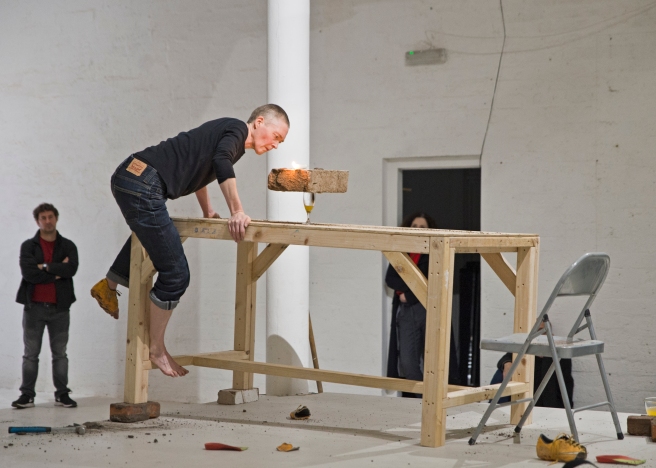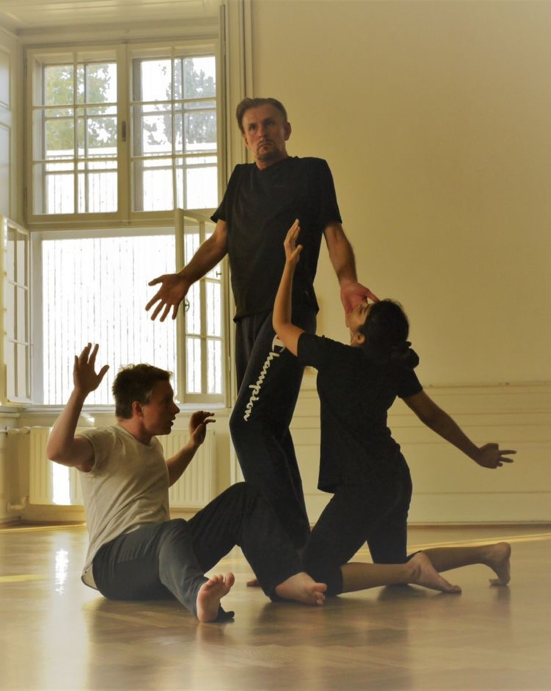by Sara Muthi
BREATHING OUT BREATING IN consisted of a stream of seamlessly curated image-making moments by six artists in one space, utilising the gallery as one canvas. Although loosely choreographed with a path and pit stops, the actions of the artists carried a genuine intensity to each image-making-process that, quite literally, took my breath away. While suffering from a persistent cough I had been conscious that I did not want my lung’s noises to take away from any moment of the performance. Ironically the subject of breathing was the backdrop to this event in the form of Nigel Rolfe’s Breath exhibition. The images exhibited were a result of Rolfe’s blowing of pigment on paper, an effect that had given an ease of lightness to them, literally that of breath. Two thin pins held up each work, giving the impression that a gush of wind could peal them off the wall at any moment.

The performing body is a complex construct and its use and manipulation of materials is integral to the analysis of every performance. However, one common factor constitutes all performance; a constant becoming without arrival. The pinned images have no sense of finality, only pause and this is reflected by each performance.
Playing a muted accordion Rolfe quietly interrupted the stillness of the room through the audible breath and slight whistle of the damaged instrument, mimetic of the subject matter at hand. Rustling deep into a white paper bag as if scrabbling to find something, a white powdered rope emerges and begins to wrap itself around Rolfe’s waist, contrasting white powder over his iconic black suit.

Paula Fitzsimons interrupts the space as she rips open the garbage bag she held, at which point a pile of stuffed animals are dropped centre-stage. Two bodies dressed in business formal attire engaging in acts seemingly not suitable for their visual status or age range— playing with dirty rope, caressing and gutting stuffed animals — creates a juxtaposition between action and expectations of self-representation. As Rolfe flings the rope anti-clockwise around himself it becomes undone. A third character enters the moment, Jade Blackstock, dressed equally as well, carrying a plate and setting it down alongside a generic bottle of milk. Finally free from the rope, Rolfe smoothly takes off his jacket and intentionally places it at the rope’s end. His spatially considerate and material based actions came to a halt yet did not disappear. Traces embodying images did not act as finalities to the action, only an intermission to give way to the next sequence of images to come.
Blackstock carries a white sack between her legs as it leaks a blood red juice, walking with difficultly and determination. A loud scream comes from her, a scream of something somehow unseen by us, yet her composure is neat, her posture is perfect, undeniably poised. An incompressible action occurs as Blackstock pours out the bottle of milk atop the shallow saucer, surely realising the flow of milk does not match the depth of her bowl and very quickly overflows. Blackstock lies down at the height of intrigue to make way for Alice Jacobs.

Dressed in a black dress with a plunging décolletage Jacobs’ head is leaned back, raspberries seem to over-fill her mouth. Her posture is in check yet her demeaner seemed drunk; another juxtaposing action against the sense of her dress. In her hand a disco ball rocks back and forth on a string, dropping suddenly only to be shattered and picked up piece by piece. Held in the crook of her arm, she stares past the audience into a void. Suddenly she’s gone leaving no trace but the bobbles of fruit which fell around her feet. While no image was left by Jacobs, her intensity of stare left an impression that carried through the atmosphere as Blackstock simultaneously stands.
Blackstock did something interesting with her performance of becoming carried through into a moment in which it attempted still life. Maintaining a sumo stance she allows herself to be weighed down by the bleeding sack she clutched to her chest; a pose that made my own thighs weak just witnessing. Breathed out of this performance was a compelling contrast of liquid materials, an image highlighting leakage and overflow.


Fitzsimons continues to gut, stack and cares the corpses of the lifeless toy animals. Eunjung Kim slowly and methodically steps into her material that she had been pouring out in the backdrop of the gallery. Not looking at her feet she begins to pace circularly atop the black sand and rice, introducing their unstable properties and lack of structure into each other. Matt Mahony Page struts into the space with a rushed attitude of unease. Following a puzzling sequence of actions he wraps a rope around a beam, pulling on the rope as if to secure its strength in supporting his weight, mission-impossible-style. He lies on his back and desperately pulls himself up against the coarse concreate floor. The exertion of action illustrates a fruitless, frivolous effort. An intervening gesture interrupts Page’s inverted climbing. As the artist pulls himself up against horizontal gravity a bristly brush scrapes on the highest points of his face, the nose, protruding tongue and chin.


While the image created by this performance did not take form of a trace of material in the gallery, perhaps more interestingly it took the form of impression upon the face of the artist, a scar easily read to be that of a rough brush. This impression will leave the gallery as opposed to being confined to the gallery space. Kim’s gesture becomes quicker as she got closer to the ground bending over with her arms out. Her gaze becomes low and she acts as the catalyst between the changing structure of these two highly intentional, specific materials in a potentially infinite action, leaving a galaxy-like image behind.

The curation of the performances that made up the event as a whole allowed for enough attention to be given to each performance, while none taking away from the other. A task not easy to achieve, BREATHING OUT BREATHING IN consisted of actions that don’t merely disappear but have real-world complex manifestations both in the gallery and out. The intensity felt throughout the course of this performance had kept my cough at bay as my attention was locked on the subtle and intentional gestures of each performance. It wasn’t until the performance concluded that my breath had remembered it needed to sporadically pulse out of my chest again.
BREATHING OUT BREATHING IN was part of Nigel Rolfe’s 8th solo show at the Green on Red Gallery, BREATH, curated by Jerome O’Driscoll. The performance was realised by six UK based artists — Jade Blackstock, Paula Fitzsimons, Alice Jacobs, Eunjung Kim, Matt Mahony Page and Nigel Rolfe on Thursday, October 12th, 2017; curated by Nigel Rolfe and Paula Fitzsimons. Images by Sara Muthi.






